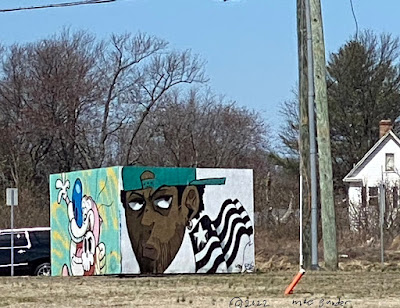The Turning Point Suffragist Memorial in Lorton, Virginia, commemorates the long struggle for women’s suffrage in the United States. In November, 1917, the suffrage movement had been pressuring for women’s voting rights and other legal rights for over 60 years. A large number of activists had been peacefully picketing the White House to keep the issue in the public eye. In fact, this was the first time the White House had been picketed by political activists.
From the beginning of Woodrow Wilson’s second term, National Woman’s Party members, known as the Silent Sentinels in distinctive purple, white and gold sashes, surrounded the White House in wordless protest. Their banners attempted to prick the president’s conscience, often charging him with hypocrisy.” (Washington Post, 2017)
 |
From an information placard at the Suffragist
Memorial: a woman protesting “Kaiser Wilson.” |
Upon the entry of the US into World War I, the protestors didn’t stop, but police actions against them became harsher and harsher.
 |
Alice Paul, shown here in a statue at the Memorial, was one of the first to be arrested.
In jail in Washington DC, she was abused and force fed. |
A mass arrest of protestors took place on November 14, 1917. A large group of women were taken to an unsanitary, abusive prison and workhouse in Lorton, Virginia, now the site of the Suffragist Memorial, which opened in 2021. The first night they spent at the Workhouse became known as the Night of Terror. They were badly beaten, given no food or water for 36 hours, and crowded into small, rat-infested cells. All their clothing and possessions were taken, and they were given filthy prison garments.
News of the treatment of the suffragists created a turning point in public opinion. Support for women’s right to vote became overwhelming, and on August 18, 1920, the 19th amendment was ratified, giving women the right to vote.
 |
| Statue of Carrie Chapman Catt, a leader of the Suffragists. |
 |
Today, voting rights issues have not entirely been resolved.
The final placards of the memorial mention continuing struggles. |
The Workhouse Today
 |
| Now at the site… |
The prison buildings where the suffragist women were held and tortured was torn down some years ago, but a large part of the old workhouse still stands, and now houses artists’ studios, art classrooms, and galleries.
 |
| The arts center is a complex of large brick buildings from the days of the Workhouse. |
 |
| We viewed exhibits of the instructors’ paintings and ceramics. |
 |
| Murals decorate the outside walls. |
We enjoyed walking on the paths in Occoquan Regional Park near the Suffragist Memorial and also walking around the adjacent Workhouse art center, taking advantage of a beautiful spring day in Virginia. Although I am aware of the general history of the suffragist movement, I was not aware of the events of 1917 that created a turning point for human rights. The placards, statues, and documentation of the memorial are very impressive, especially the panel with the names and dates of every woman who was imprisoned at the site.
blog post © 2022 mae sander.












13 comments:
It's an important part of our history. It's still shocking to me when I remember that my grandmother had 3 children before she was allowed to vote.
It´s "unbelievable" women had to fight so hard and were treated so horribly.
If they saw how many women (and men) these days choose NOT to vote, they surely would cry.
Thank you for sharing this informative post. I knew about the movement, but not the turning point to which you referred. Some of us are still fighting for our right to vote, with new restrictive voting laws in many red states, one of which is Kansas. The state just redrew redistricting areas so the democrat who is in office will very likely not be reelected because they cut her district apart. More than ever, it is time for women to stand up and vote.
This looks like a fascinating place and a wonderful spot to visit. The history is so important. I'm glad it still exists as such.
It's too bad women had to work so long for voting rights, in fact rights in general. I would have found it hard to live back then in some ways, as I like to speak my mind, at least with my husband, often. Happy FRiday. Hugs-Erika
What an amazing way to honour the women who paved the way for the future. And maybe a way to provide a future for women today. Love the photo taken through the fence.
Great post and photos. It is hard to believe people in our country are still fighting for the right to vote. The memorial looks like a great place to visit. Take care, enjoy your day and happy weekend!
Interesting. It would be a great place to visit with my teenage grandkids! thanks for the review.
thank you very much for this report which honors the memory of the sufragettes. The photos are very good. Have a good week
This is a beautiful memorial park that admires great people. These statues and also the murals are beautiful. I like to visit such places.
Have a great day!
An important topic - great to see it so well covered
An important part of history, specially for women.
Sadly women still don't have equal rights to men in many countries.
Nice murals and "love" sign and beautiful statue of Alice Paul.
Thanks for participating in Monday Murals Mae.
And yet we are still not completely equal.
I have marked this as a stop on our next road trip!
Post a Comment